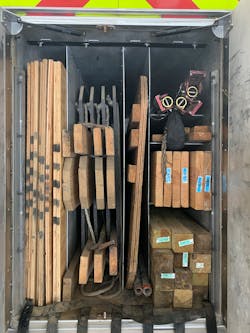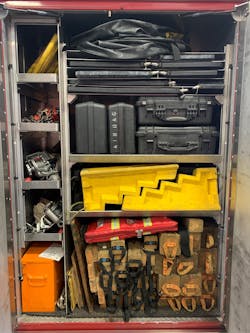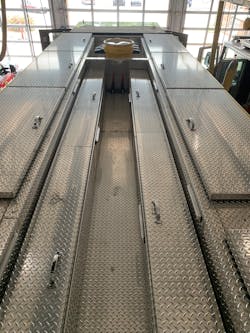Heavy rescue apparatus arguably are the most difficult apparatus to design. This largely is because of all of the specialized equipment that’s required to carry out the duty of the company, which can vary greatly depending on the department’s region.
Conducting a thorough apparatus needs analysis aids in determining the required duties that your heavy rescue apparatus must be outfitted to fulfill within your community as well as your extended running areas.
Breaking it down
Heavy rescue apparatus are essential assets to meet your pledge to protect the community that you serve. These apparatus come in numerous configurations: combination apparatus of all types (i.e., Squads, rescue-ladders), wet versus dry, single-chassis versus tandem-chassis configurations, two-door versus four-door cab configurations and walk-around bodies versus walk-in bodies. Each varies greatly from the other; however, the duty of the apparatus is the key factor for which variety will work for you, because vehicle duty determines your body configuration to house all of the appropriate equipment.
Your apparatus needs analysis determines what the required duties of your apparatus will be. Heavy rescue companies can be tasked with any of the following duties: structural firefighting, vehicle extrication, low- and high-angle rope rescue, hazmat metering and mitigation, elevator/machinery extrication, structural collapse/shoring, swiftwater rescue, trench rescue and confined-space rescue, just to name a few. Once your local list of duties is compiled, the duties then must be prioritized, and a required equipment list for each duty must be generated based on the level of the discipline that you plan to achieve (operations vs. technician). (Note: The above order of duties of a heavy rescue is from a recent apparatus needs analysis for a heavy rescue company. I assisted with that analysis. The order of duties is included here simply as an example. It’s prioritized by frequency and supplemental apparatus/specialized teams’ capability to augment equipment cache and personnel.)
Compartmentation
Incidents that require the duties of a heavy rescue company are far less common than those of standard engine and truck companies. This in no way lessens a heavy rescue’s worth to a community, because these incidents regularly deal with difficult situations in compressed time frames to ensure the survivability of the patient(s) who is involved. To ensure this, staffing, training and equipment caches are essential. Heavy rescue apparatus bring all three of these metrics together, again, to ensure the efficiency, effectiveness, and safety of both personnel and patients.
Many organizations opt to run small power take-off pumps and reduced water tanks on their heavy rescue apparatus. This, too, has a great effect on determining the body layout of a heavy rescue as related to space, weight and hoseline/discharge configurations.
Chassis configurations also play a significant role in designing compartmentation. It’s important during this phase not to let the rig get away from you. That is, it’s easy to continue to “stretch the envelope” in a way by which an apparatus ends up having a wheelbase that’s too long to navigate around your first-due response area. (Once you start to creep past a 230-inch wheelbase, you can have difficulty navigating around most communities. Changing chassis configurations can aid in keeping your wheelbase manageable.)
Second, keep the equipment that members of the company utilize most frequently right at hand. For most of the heavy rescue companies in the United States, this is the firefighting equipment that’s based on the organization’s pre-determined heavy rescue assignments that play out on the fireground.
As you progress farther away from the crew’s seating configuration, you should decrease in the frequency of the duties of your company, although this varies between walk-in and walk-around bodies based on the crew area.
The weight of portable equipment as well as bulk portable equipment also plays a significant role in the layout of compartmentation. Certain equipment has specific storage requirements. For example, air struts are preferred to be stored vertically, to keep the gasket from getting a flat spot. Air struts come in various diameters and retracted lengths based on manufacturer; however, it usually is possible to get 96-inch retracted struts vertically mounted in compartments based on your specified compartmentation layout. Longer struts likely must be carried horizontally and rotated routinely.
Boat motors can cause duress to the specification of compartmentation. Ideally, you want to keep the motor mounted vertically, with fuel in it, so it’s ready to go immediately. This mounting takes a considerable amount of time to lay out, particularly with the weight of some larger-horsepower motors, which might need to be mounted on a drop-down lift. If you carry a bag boat with the motor, this, too, takes a considerable amount of storage space down low.
Rooftop storage compartments are a great option for carrying lighter-weight and bulk items on walk-around heavy rescue bodies. These items likely are farther down on your company’s duty list; therefore, they don’t need to be as accessible as the more frequently utilized equipment. Bulk hazmat equipment is an example of this. This can include suits, decontamination equipment, leak kits, pads and booms, all of which take up a considerable amount of space.
Equipment for confined-space rescue can take up a considerable amount of storage space. Rooftop storage is a good place to keep air/communication/tag lines, fans and ducting. If your company’s duties include supplying air on the fireground, cascade cylinders fit well into these compartments. (Most hydrostatic testing for cylinders isn’t required but for every 10 years or longer.)
Cab and walk-in storage areas might be the most valuable storage space that’s on a heavy rescue, because they place much-needed equipment right at the hands of the personnel who are on the unit. The equipment that’s placed in these locations is based on the prioritized duties of the apparatus.
(Note: Cab and walk-in equipment storage areas have been a point of contention among the members of many apparatus specification committees for quite some time. Some organizations adamantly oppose it while others embrace it. I’m a proponent of keeping clean equipment in the cab and walk-in bodies of heavy rescues.)
When you consider the duties that members perform via your heavy rescue companies, you must take an objective look at the amount of time that you have at your disposal to complete these tasks when you arrive at the incident. It takes time to get dressed-out in swiftwater gear, dive suits and ice suits. This is time that can be incurred during your response and not after you arrive, the latter of which a victim(s) quite possibly might not have, particularly with the distance that you might need to cover to get to the incident in specialized units. Keeping these suits in the crew compartment can cut on-scene reaction time/time to get personnel in the water quite drastically.
Storing hazmat metering equipment is another good utilization of this space. This approach allows battery charging stations to be built into these climate-controlled compartments, so personnel are permitted to “grab and go.”
Sensitive paramedic equipment, such as drug boxes and monitors, are a good utilization of this interior, climate-controlled storage, too.
Determining factors
Conducting a thorough apparatus needs analysis greatly aids in an apparatus committees’ specification process for a heavy rescue. The list of duties should be the driving force behind the equipment cache that you’re required to carry. All of the compiled data is utilized in the design of your cab, body and chassis configuration.
Combination Rescue Apparatus
Many communities augment their heavy rescue companies with combination apparatus. Combination apparatus come in two main types: rescue-engines (Squads) and rescue-ladders. It must be noted that there isn’t one apparatus type that will work for every community nor is there one that can mitigate 99 percent of incidents. I know of several attempts to accomplish this that ended with disastrous results.
Although you might get many duties started with this type of combination apparatus, you must ensure that you immediately supplement these units. They simply don’t carry the depth of equipment that’s required to mitigate many technical-incident types.
Furthermore, often, you end up struggling to complete the primary duty of the apparatus: the primary engine or truck company on the fireground.
About the Author

Mark Miller
Mark Miller is a 26-year veteran of the fire service and currently is a deputy fire chief in Southwest Ohio. He holds a master’s degree in public safety administration, the Executive Fire Officer designation from the National Fire Academy and the Chief Fire Officer designation through the Center for Public Safety Excellence. Miller routinely speaks on fire apparatus positioning on the fireground and conducting an apparatus needs analysis.



